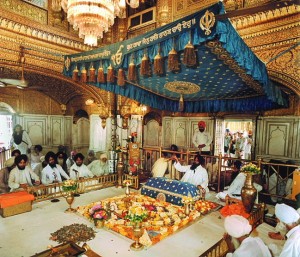Articles/Opinion » Selected Articles
Understanding the Kirpan (by World Sikh Organization of Canada)
January 29, 2013 | By Editor
Sikhism
 The Sikh religion is the youngest of the five major world religions. It originated in northern India in the late 1400s, with its founder, Guru Nanak who was a spiritual teacher and social reformer. He directed people to meditate daily (nam japna), work hard (kirat karna), and share their earnings with others without discrimination (vand shakna). These three enjoinders have become the pillars of Sikh society.
The Sikh religion is the youngest of the five major world religions. It originated in northern India in the late 1400s, with its founder, Guru Nanak who was a spiritual teacher and social reformer. He directed people to meditate daily (nam japna), work hard (kirat karna), and share their earnings with others without discrimination (vand shakna). These three enjoinders have become the pillars of Sikh society.
 Sikhs are monotheists who believe in the equality of men and women as a fundamental tenet of their faith. They believe in the equality of all humanity, irrespective of race, religion, or culture.
Sikhs are monotheists who believe in the equality of men and women as a fundamental tenet of their faith. They believe in the equality of all humanity, irrespective of race, religion, or culture.
There are approximately 22 million Sikhs worldwide, living predominately in India, U.K., and North America.
The Kirpan
The kirpan is often described as a dagger or a miniature sword, which is what it resembles, but that description is so far removed from the purpose of a kirpan as to make it misleading. The kirpan is an article of faith that plays a role in the Sikh religion that is similar to that of a Christian cross, a Jewish Star of David, or a Muslim hijab, with one crucial exception: it is not optional. As has been noted in Canadian jurisprudence,
“The kirpan as one of the five k’s is thus far more than a religious adornment. Mandated to be worn always, it is an integral part of the Khalsa Sikh’s person and cannot be properly compared with a cross which a Christian might choose to wear. Not wearing the kirpan at any time, day or night, constitutes a grievous transgression for a Khalsa Sikh.”
The word kirpan means mercy or grace and the kirpan is worn by initiated (Amritdhari) Sikhs, both men and women, and is one of five articles of faith, often called the 5Ks. Sikhs wear them as a reminder of their commitment to the tenets of their faith including justice, charity, morality, humility, and equality. These articles of faith are:
- Kesh — unshorn hair symbolizing respect for God’s will; covered at all times with a keski or dastar (turban);
- Kangha — a wooden comb representing self-discipline; worn in the hair it reminds the wearer to rid oneself of what is morally undesirable;
- Kara – an iron or steel bracelet worn on the wrist; the circle signifies the oneness and eternity of God and to use one’s hands to benefit humanity;
- Kachhera – cotton undergarments representing high moral character and fidelity;
- Kirpan – a stylized representation of a sword, which must be worn sheathed, wrapped in a cloth belt, and worn next to the body; the kirpan signifies the duty of a Sikh to stand up against injustice.
Kirpans must be made of iron or steel and most range in size from 15 to 22 cm (6-9 inches) but sizes do vary depending of the preferences of the wearer. Some have elegant, ornate hilts and sheaths. They must be held securely in place with a fabric belt (called a gaatra). The gaatra is worn across the torso, keeping the kirpan next to the body.
Canadian Courts have accepted that,
“[t]he Kirpan is also the symbol of sovereignty and dignity. I suppose in a similar way…that in the Canadian parliament below the speaker’s chair we have a mace which is an undoubted weapon and a reasonably brutal one. But this mace goes far beyond the aspect of being a weapon, but is instead a symbol of authority, a symbol of dignity, a symbol of sovereignty as it were the body that is involved.”
We all handle blades of all sorts daily, in public. Letter openers, scissors, knives in restaurants, kitchen knives, nail files, Swiss Army knives, scalpels, saws, ice skates… the list is long. It grows longer if we add forks (which are still found on airplanes) and other sharp, pointy implements. But we assume these tools will be used for their intended purpose, and we don’t assume our neighbours and coworkers are dangerous.
What prevents Sikhs using an article of faith for violence is that very faith, coupled with the same social customs that we all observe. Of all the blades used in daily life, kirpans are the least hazardous because they are sacred: they come with a philosophy that is an integral part of how Sikhs practise their faith. It’s not just a talisman or a piece of jewelry. Removing the kirpan is a serious matter for Sikhs. It is done rarely and only under extreme circumstances – Sikhs even wear the kirpan while sleeping and bathing. Parting with this article of faith, even briefly, requires prayer.
The idea of a Sikh attacking someone with a kirpan is far more frightening, horrifying, and repugnant to those of our faith than to anyone outside it.
The Law:
Legislators, the Canadian courts, and even the security conscious 2010 Vancouver Olympics have all ruled that the kirpan should not be viewed as a weapon, it is an article of faith.
In a unanimous 2006 decision on whether a Quebec boy could wear his kirpan at school, the Supreme Court of Canada ruled that kirpan is not a symbol of violence and that it does not pose an undue hazard. To assume it does is “disrespectful to believers in the Sikh religion.”
“There are many objects in schools that could be used to commit violent acts and that are much more easily obtained by students, such as scissors, pencils and baseball bats,” the judges said in their decision.
NOTE: Above write-up was originally published at worldsikh.ca, under title: Understanding the Kirpan. Visitors/Readers of Sikh Siyasat News may find this article on source page at: http://worldsikh.ca/page/understanding-kirpan
To Get Sikh Siyasat News Alerts via WhatsApp:
(1) Save Our WhatsApp Number 0091-855-606-7689 to your phone contacts; and
(2) Send us Your Name via WhatsApp. Click Here to Send WhatsApp Message Now.
Sikh Siyasat is on Telegram Now. Subscribe to our Telegram Channel
Related Topics: Kirpan, Kirpan Issue, Sikh Diaspora, Sikh Identity, Sikh News Canada, Sikh Religion, Sikhism





